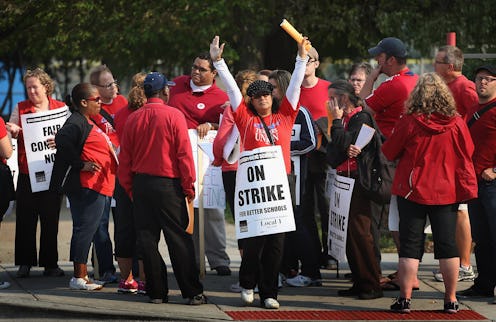News
Arizona Teachers Are Striking Now & You Need To Know About It

Thousands of teachers in Arizona walked out of school on Thursday, joining a rapidly growing movement of educators across the nation who are striking this year. Around three-quarters of Arizona's public and charter schools shut down because of the strike, and the closings affected hundreds of thousands of students. Here's why Arizona teachers are striking.
The first major reason is pay, which teachers argue is unreasonably low. The president of the state's biggest teachers union, Joe Thomas, told The New York Times that public school educators often start off with a salary of $35,000. The state's average teacher salary was $48,372 last year, according to a report from the auditor general (the National Center for Education Statistics puts it slightly lower, at $47,000). Both the NCES and the National Education Association estimated the average teacher salary in the United States for the 2016-2017 school year to be around $58,000, about $10,000 higher than the average in Arizona.
Arizona's teachers receive some of the lowest teacher salaries in the country, and their wages aren't enough to meet the living standards for many cities across the state. A 2016 GoBankingRates estimate analyzed that residents of Phoenix, the state's capital, needed an income of $48,876 to "live comfortably" in the city. Tucson residents were estimated to need $39,966, the smallest amount required for any of the United States' biggest 50 cities. A new teacher making $35,000, as Thomas described, would not be able to "live comfortably" by that standard in either Phoenix or Tucson.
Arizona's governor, Doug Ducey, promised teachers a 20 percent raise by 2020 in hopes of avoiding the strike altogether, but his efforts were unsuccessful. Even a 20 percent raise wouldn't quite bring salaries up to the national average — and many teachers were unconvinced by his promise, anyway.
Ducey said that he'd be able to boost their pay without raising taxes, estimating that the state's forecasted economic growth would compensate. The New York Times reports that "many teachers and lawmakers doubted" that this would be possible. But even if the 20 percent salary increase had been guaranteed, it still wouldn't have addressed teachers' second major demand.
The second big reason teachers are striking is a purported lack of resources and poor conditions within schools. Images of rats in classrooms, mold on books, broken chairs, and leaking ceilings have been publicized by Arizona teachers and circulating the internet this week. The state's auditor general notes that Arizona's education budget invested $8,141 per student last year. That figure falls far short of the national average, which was $11,454 in 2015, according to NCES.
Many Arizona teachers report having to pay for classroom supplies out of their own pockets to compensate for this shortage in funding. Combined with their low salaries, they say that this puts unsustainable financial strain on them. According to the Joint Legislative Budget Committee via AZCentral.com, Arizona now spends $924 less per pupil than it did in 2008, when adjusted for inflation. Bringing those numbers back in alignment would mean adding an additional $1 billion to the state's education budget.
Arizona teachers voted to move forward with the strike last Thursday. Over a three day period, 57,000 teachers cast ballots about the initiative; 78 percent of them voted in favor of the strike, according to the Arizona Education Association.
The Arizona Republic estimated that over 840,000 Arizona youths, or 76 percent of all its public school students, would be affected by school closures during the strike on Thursday. This week marked the first time that teachers had ever participated in a walkout that spanned the whole state. Many teachers are expected to continue the strike into Friday.